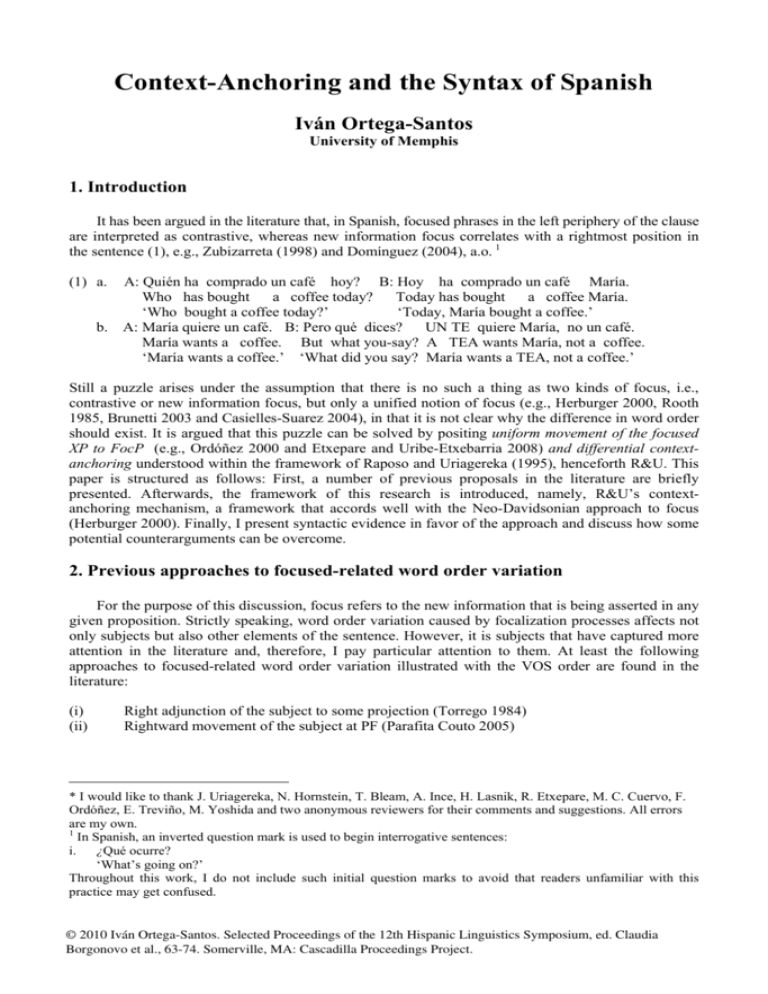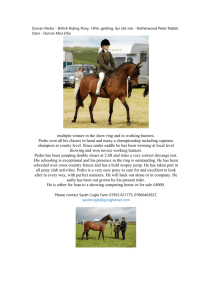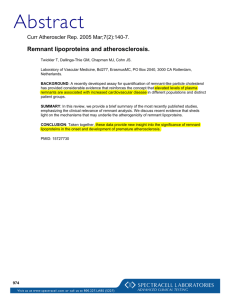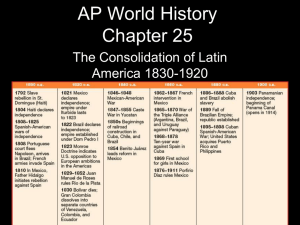
Context-Anchoring and the Syntax of Spanish
Iván Ortega-Santos
University of Memphis
1. Introduction
It has been argued in the literature that, in Spanish, focused phrases in the left periphery of the clause
are interpreted as contrastive, whereas new information focus correlates with a rightmost position in
the sentence (1), e.g., Zubizarreta (1998) and Domínguez (2004), a.o. 1
(1) a.
A: Quién ha comprado un café hoy? B: Hoy ha comprado un café María.
Who has bought
a coffee today?
Today has bought a coffee María.
‘Who bought a coffee today?’
‘Today, María bought a coffee.’
b. A: María quiere un café. B: Pero qué dices?
UN TE quiere María, no un café.
María wants a coffee. But what you-say? A TEA wants María, not a coffee.
‘María wants a coffee.’ ‘What did you say? María wants a TEA, not a coffee.’
Still a puzzle arises under the assumption that there is no such a thing as two kinds of focus, i.e.,
contrastive or new information focus, but only a unified notion of focus (e.g., Herburger 2000, Rooth
1985, Brunetti 2003 and Casielles-Suarez 2004), in that it is not clear why the difference in word order
should exist. It is argued that this puzzle can be solved by positing uniform movement of the focused
XP to FocP (e.g., Ordóñez 2000 and Etxepare and Uribe-Etxebarria 2008) and differential contextanchoring understood within the framework of Raposo and Uriagereka (1995), henceforth R&U. This
paper is structured as follows: First, a number of previous proposals in the literature are briefly
presented. Afterwards, the framework of this research is introduced, namely, R&U’s contextanchoring mechanism, a framework that accords well with the Neo-Davidsonian approach to focus
(Herburger 2000). Finally, I present syntactic evidence in favor of the approach and discuss how some
potential counterarguments can be overcome.
2. Previous approaches to focused-related word order variation
For the purpose of this discussion, focus refers to the new information that is being asserted in any
given proposition. Strictly speaking, word order variation caused by focalization processes affects not
only subjects but also other elements of the sentence. However, it is subjects that have captured more
attention in the literature and, therefore, I pay particular attention to them. At least the following
approaches to focused-related word order variation illustrated with the VOS order are found in the
literature:
(i)
(ii)
Right adjunction of the subject to some projection (Torrego 1984)
Rightward movement of the subject at PF (Parafita Couto 2005)
* I would like to thank J. Uriagereka, N. Hornstein, T. Bleam, A. Ince, H. Lasnik, R. Etxepare, M. C. Cuervo, F.
Ordóñez, E. Treviño, M. Yoshida and two anonymous reviewers for their comments and suggestions. All errors
are my own.
1
In Spanish, an inverted question mark is used to begin interrogative sentences:
i. ¿Qué ocurre?
‘What’s going on?’
Throughout this work, I do not include such initial question marks to avoid that readers unfamiliar with this
practice may get confused.
© 2010 Iván Ortega-Santos. Selected Proceedings of the 12th Hispanic Linguistics Symposium, ed. Claudia
Borgonovo et al., 63-74. Somerville, MA: Cascadilla Proceedings Project.
64
(iii)
(iv)
(v)
(vi)
(vii)
P(rosodic)-movement of presupposed phrases past the in situ subject (Zubizarreta 1998)
Pronunciation of the low copy of the subject to meet Sentence Stress Assignment conditions,
under the assumption that all arguments and (the verb) vacate vP / VP, arguably for Case
checking purposes à la Chomsky (1995) (Ortega-Santos 2006a and 2006b, following
Stjepanic’s 1999 analysis of Serbo-Croatian)
Object scrambling past the (in situ) subject (Ordóñez 2000, Etxepare and Uribe-Etxebarria
2008 and López 2009; cf. also Gallego 2007)
Movement of the subject to a Focus projection at the VP periphery and movement of the
presupposed material to a clause internal Topic projection higher than this Focus projection
(Belletti 1999 and Etxepare and Uribe-Etxebarria 2008)
Remnant movement (Kayne and Pollock 1999 for French and Ordóñez 2000 and Etxepare
and Uribe-Etxebarria 2008 for Spanish)
Novel evidence for the remnant movement approach to (at least a subset of) focused subjects at the
right edge of the sentence within R&U’s (1995) context anchoring mechanism is provided below
(section 3.3). Additionally, some counterarguments found in the literature are answered.
3. Analysis
A number of researchers working on a variety of frameworks have argued that the existence of such
diverse interpretations as new information and contrastive focus does not imply that there are distinct
focalization processes in Spanish or in any language (e.g., Brunetti 2003, Casielles-Suárez 2004 and
Herburger 2000). 2 In the words of Casielles-Suárez (2004: 142), “focus in general has been claimed to
make a set of alternatives salient (Rooth’s 1985 p-set) in all cases. From this point of view, the fact
that some of these alternatives may be in some cases more obvious or even totally spelled-out does not
change the nature of focus”. 3 Given this, the left-periphery or rightmost position of the focused phrase
cannot follow from semantic differences of the focused phrase or the kind of focus involved. It is
argued that R&U’s independently motivated framework of context-anchoring provides a way to
account for this variation in the word order of sentences containing focused-phrases, when combined
with uniform movement to Foc,P in the case of both leftmost and rightmost focus. More specifically, I
argue that i. both new information focus and left-periphery contrastive focus are the result of
movement as suggested by a number of pieces of evidence, e.g., the licensing of parasitic gaps and
syntax of governed infinitives; ii. the rightmost / leftmost position of the focused XP follows from
differential context anchoring.
3.1. Raposo and Uriagereka (1995)
For R&U, contexts are set within other contexts, much as quantifiers have scope inside one another.
Under the assumption that X is the context of the subject S and Y is the context of the predicate P, a
sequence of contexts <X,Y> is interpreted differently from a sequence of contexts <Y,X>. ‘The first of
these sequences would introduce a context Y for predicate P within the context X for subject S.
Conversely, the second sequence would introduce a context X of the subject within the context of the
predicate’ (R&U: 191). This means, for instance, that in the SV order, the subject will anchor the
predicate, whereas in the VS order the predicate will anchor the subject. Arguably, this underlies the
categorical/thetic interpretation of the sentence as determined by the position of the subject:
(2) a.
2
Pedro ha llegado.
Pedro has arrived
‘Pedro has arrived.’
Categorical reading of ‘Pedro’
E.g., according to Herburger (2000: 52-58), contrastiveness and exhaustiveness are not intrinsic properties of
focus. This researcher considers that these ‘effects’ in English result from the pragmatics of intonation contours
and, again, not from the properties of focus.
3
In what follows, I adopt this view and I use the labels new information and contrastive focus only for the sake of
exposition without any theoretical import.
65
b.
Ha llegado Pedro.
has arrived Pedro
Thetic reading of ‘Pedro’ 4
Within R&U’s framework, context-anchoring is linked to a particular LF site. This particular aspect is
not adopted in this research. There is a growing consensus in the literature that Internal Merge (IM) or
syntactic movement adds expressive power to language (e.g., see Chomsky 2001 and subsequent
work). Chomsky argues that the mapping between the Duality of Semantics and the Duality of Merge
is systematic. In the words of Chomsky (2005: 7): ‘To a large extent, EM yields generalized argument
structure (theta roles, the “cartographic” hierarchies, (...) and similar properties); and IM yields
discourse-related properties such as old information and specificity, along with scopal effects’.
Uriagereka (2008) provides a rationale for this kind of view arguing for the idea that mapping a more
or less entangled syntax specifically to a semantics of comparable complexity is realistic, both from a
developmental (learnability) and, ultimately, an evolutionary (minimalistic) perspective. Thus one can
maintain the insights of R&U’s context-anchoring mechanism, without the need to resort to specialized
projections. In what follows, labels as FocP or TopP are used for the sake of exposition.
In the next section it is shown how R&U’s framework and the mapping of complex syntax onto
complex semantics (Chomsky 2005 and Uriagereka 2008) provide a rationale for the word order
variations caused by focalization processes in Spanish.
3.2. Word order variation, focus and remnant movement
In this section, I apply R&U’s context-anchoring mechanism to the syntax of focus. In particular, I
argue in favor of capturing the left-peripheric and right-peripheric position of focus phrases in Spanish
in terms of uniform movement of the focused XP to the left periphery –resulting in the leftmost
position of the focused XP-, followed by remnant movement of IP in a number of cases –resulting in
the rightmost position of the focused XP (Ordóñez 2000 and Etxepare and Uribe-Etxebarria 2008).
This perspective entails that the syntax of new information and contrastive focus in Spanish are fairly
similar, in keeping with the view that there is only one kind of focus (e.g., Brunetti 2003, CasiellesSuárez 2004 and Herburger 2000). Specifically, both left-periphery and rightmost focus show uniform
movement of the focused XP to FP, but the topicalization of TP takes place covertly in the former case
and overtly in the latter. 5
Under current assumptions that EPP features responsible for syntactic movement, in general, are
optionally assigned to yield a new outcome, the left periphery of the clause includes an EPP feature in
FocP and, optionally, it may include an EPP feature in TopP. Depending on the presence or absence of
an EPP feature in TopP, the presupposed information will or will not surface there, thus deriving
rightmost and left-periphery focus, respectively. 6 , 7
4
See Ortega-Santos (2008) for further elaboration of the categorical/thetic distinctions based on work by
Casielles-Suarez (2004). A reviewer asks whether the thetic/categorical distinction is exemplified by the following
data from Gallego (2007):
i. a. Juan escribe.
Juan writes
‘Juan is a writer’
b. Escribe Juan.
writes Juan
‘Juan is writing now / It is Juan who writes.’
I agree that this contrast is relevant in that it shows a clear difference in interpretation, but it is contingent on the
semantics of the verb, cf. (2), and even the presence/absence of adverbial modification. In this sense, the
thetic/categorical distinction is more general than this effect.
5
Note that this framework allows for contrastively focused items to appear at the right edge. This order is indeed
possible in Spanish.
6
This analysis could be restated in phase-theoretic terms, assuming the optional assignment of EPP features in the
C-domain. As one reviewer points out, one such approach to preverbal focus in phase-theoretic terms is found in
López (2009). The present view differs crucially from López’s approach in that rightmost new information focus
is shown to involve movement as opposed to being in situ.
7
This accords well with Herburger’s (2000) Neo-Davidsonian approach to focus. According to Herburger (2000),
focus affects quantificational structure. In particular, focus reshapes the quantificational structure of the tacit NeoDavidsonian event quantifier after quantifier scope is assigned. As a consequence, all the nonfocused material in
66
3.2.1. On the leftmost/rightmost position of focalized elements
A number of scholars working on Italian have shown that the background material preceding focalized
elements and the background material following these have rather different properties. In the words of
Brunetti (2003: 158), ‘prefocal material has a “richer” set of functions’. In particular, Frascarelli (2000
and 2003; see also references therein) observes that a post-focal topic cannot be ‘contrastive’ as
opposed to a preverbal topic. Under the view that IM adds expressive power to the system, that is to
say, that complex syntax correlates with complex semantics/pragmatics, it is consistent to argue that
these (richer) set of functions underlie the movement of presupposed material to the prefocal slot, thus
determining the leftmost or rightmost position of the focused phrase. Further effects of this movement
on interpretation would follow from R&U’s context-anchoring mechanism: prefocal topics set the
context in which the focal XP is interpreted, whereas postfocal topics are interpreted within the context
of the focused XP. Within this proposal, the topicalization of TP is not stipulated, but rather is driven
by the way the speakers conceptualize events, their participants, corresponding predications and their
contexts. 8
With regard to new information focus, this view entails a remnant movement approach (Ordóñez
2000 and Etxepare and Uribe-Etxebarria 2008) where, crucially, all steps are motivated. 9 Furthermore,
the rightmost position of focused XP’s which constitute new information focus is consistent with
default Sentence Stress Assignment conditions for new information focus in Spanish (cf. Zubizarreta
1998)
3.3. Evidence for the analysis
Evidence in favor of the remnant movement approach to focused elements at the right edge of the
clause comes from the syntax of parasitic gaps, scope relations between negation and focused XPs, the
island-properties of adjuncts and the syntax of overt subjects following an infinitive.
3.3.1. Parasitic gaps
Parasitic gaps are known to be licensed under A-bar movement (see (3) and (4) for wh-movement and
focus-movement, respectively), but not under A-movement or by in situ arguments (see (5)):
(3) Qué (libros) tiraste
sin
haber leído/fotocopiado ___?
What (books) threw-you without to-have read/copied ____?
‘What / Which books did you throw away without reading/copying?’
(4) (Hasta) DON QUIJOTE Y LA COLMENA
tiré
sin
haber leído/fotocopiado___.
(Even) DON QUIJOTE AND LA COLMENA threw-I without to-have read/copied ___
(5) *Tiré Don Quijote y La Colmena sin
haber leído/fotocopiado ___.
Threw-I Don Quijote and La Colmena without to-have read/copied ___
‘I threw away Don Quixote and La colmena without reading/copying them.’
the scope of the event quantifier Q also restricts Q. Uriagereka (2005 and 2008) and Hornstein, Lasnik and
Uriagereka (2007) suggest that a possible syntactic configuration to express these semantics can be attained by
remnant movement, which has the effect of reprojection (Hornstein and Uriagereka 1999). Reprojection is a
process whereby a phrase marker’s label changes in the course of the derivation. This process allows binary
quantifiers to take scope (at LF). See Hornstein and Uriagereka (1999) for details. If right, this provides a rationale
for the derivations I argue for. See also Irurtzun (2007) for a related proposal concerning the syntax of focus and
reprojection.
8
Naturally, presupposed information will anchor new information (see Erteschik-Shir 1997 and Kiss 2002) and,
consequently, the new information will come to be last. If anything, these pragmatic requirements are soft
constraints, in keeping with a certain degree of variability found in the judgments of the leftmost / rightmost
position that focused XP’s take.
9
There is no claim that this is the only way of deriving focused postverbal subjects, but rather that remnant
movement derivations to focused subjects do exist. See Etxepare and Uribe-Etxebarria (2008) for evidence that on
top of the remnant movement approach to focused postverbal subjects other mechanisms are also available.
67
Since subjects do not license c-commanded parasitic gaps, one cannot test whether they do so when
relevantly focused. Still, the properties of objects directly support the view that elements which
constitute new information focus have moved to the A-bar layer. In particular, if an object at the right
edge of the clause constitutes new information focus, the remnant movement approach predicts that the
parasitic gap should be licensed, as by hypothesis the (sentence final) object would be the result of
movement, going through an intermediate stage analogous to (4). This prediction is fulfilled, as B’s
utterance in (6) shows (compared to (5)).
(6) A: Qué (libros) tiraste
sin
haber leído/fotocopiado ___?
What (books) threw-you without to-have read/copied ___?
‘What / Which books did you throw away without reading/copying?’
B: Tiré
sin
haber leído/fotocopiado DON QUIJOTE Y LA COLMENA.
threw-I without to-have read/copied
DON QUIJOTE AND LA COLMENA
‘I threw away Don Quixote and La colmena without reading/copying them.’
Inasmuch as new information focus, with its rightmost requirement, is not restricted to objects but
extends to subjects as well, it seems coherent to conclude that (at least a subset of) postverbal subjects
are also the result of A-bar movement, and, concretely, remnant movement as discussed above.
3.3.2. Scope relations between focused XPs and negation
Ortiz de Urbina (2002), when discussing a similar analysis of Basque rightmost focus, shows that both
leftmost and rightmost focused items take scope over negation, in spite of the fact that the latter
linearly follows negation. This indicates that the focused XP in the rightmost position is higher than
the linear order suggests, in keeping with the remnant movement analysis. The argument is
straightforwardly applicable to Spanish, in that the focused element has scope over negation
irrespective of the leftmost or rightmost position it occupies (7)a/b, in clear contrast to non-focused
XPs linearly following negation (7)c:
(7) a.
A ANDONI no le traje el vino
to Andoni not him bring the wine
‘It is to Andoni that I did not bring the wine.’
b. No le traje el vino a ANDONI.
not him-brought the wine to Andoni
‘It is to Andoni that I did not bring the wine.’
c. No le traje el vino a Andoni
not him bring the wine to Andoni
‘It is not the case that I brought wine to Andoni.’
These scope facts can be explained if topicalized material is reconstructed in its original position (Ortiz
de Urbina 2002). This reconstruction is independently attested (Suñer 2003: 350, her data; see also
Zubizarreta 1998: 116):
(8) *La primera obra de un escritori, proi siempre la escribe con placer.
The first
work of a writeri, proi always it writes with pleasure
In this example the ungrammaticality is due to a Principle C violation. Crucially, this entails that the
dislocated object reconstructs into its base position. A unified analysis of leftmost and rightmost focus
in terms of movement to the left-periphery of the clause, (followed by movement of the remnant IP
past the focused XP in the case of rightmost focus), captures these interpretation facts.
3.3.3. Adjuncts
Note that the subject of a main clause may follow an embedded clause when focused as predicted by
the remnant movement account:
68
(9) A: Quién dijo que hacía calor?
who said that it-was hot?
‘Who said that it was hot?’
B: Dijo que hacía calor PEDRO.
said that it-was hot PEDRO
‘PEDRO said that it was hot.’
In contrast, if the originating clause of the focused XP at the right edge of the clause is an island, e.g.,
an adjunct, the result is ungrammatical (see Ortiz de Urbina 2002 for Basque), a fact that can be
interpreted as evidence that rightmost focalization involves movement:
(10) Cuando Pedro compró ese libro, nos
fuimos.
when Pedro bought that book, we-reflexive left.
‘Once Pedro bought that book, we left.’
(11) *Cuando compró ese libro, nos
fuimos PEDRO.
when bought that book, we-reflexive left
PEDRO.
3.3.4. On Postverbal subjects and infinitives in Spanish
Further evidence for the remnant movement approach to postverbal subjects in Spanish comes from
the distribution of postverbal subjects following governed infinitivals. Subsection 1 discusses the
licensing of overt subjects following governed infinitivals. It is argued that those subjects are
arguments of the main verb in spite of what linear order may seem to suggest at first. Subsection 2
discusses further properties of these kinds of subjects, in particular c-command relationships between
the subject and the object of the infinitive (Ordóñez 2000), showing that these relationships provide
evidence in favor of the remnant movement approach.
3.3.4.1. Overt subjects following governed infinitivals
In Spanish, infinitives show no tense and agreement and are predicted not to license overt subjects.
Governed infinitives have been claimed to be well-behaved in this respect, (12), in contrast to
ungoverned infinitives, (13), which license overt subjects (see Ortega-Santos 2002 for a
reinterpretation of this asymmetry in terms of L-marking). A number of approaches have been
developed accordingly (Fernández Lagunilla 1987, Rigau 1995 and Torrego 1998, a.o.).
(12) a.
Pedro lamentó no haber ido.
Pedro regretted not to-have gone
‘Peter regretted that he did not go’
b. (Ayer)
lamentó no haber (*Pedro) ido (*Pedro). 10
(yesterday) regretted not to-have (*Pedro) gone (*Pedro)
(13) a. Al entrar Juan, todos
salieron.
at to-enter Juan, everybody left.
‘When Juan entered, everybody left’
b. ¿Regalarles yo mi coche?
to-give-them I my car?
‘I would never give them my car’
Still, Spanish allows for sentences, where a governed infinitive is followed by a focused subject:
(14) (Ayer)
lamentó no haber ido PEDRO.
(yesterday) regretted not to-have gone PEDRO.
10
This judgment corresponds to the interpretation where ‘Pedro’ is not focused.
69
It is argued that the overt subject in (14) is the subject of the main clause. The discussion is
exemplified with lamentar ‘lament’, because its incompatibility with clitic climbing shows that we
have a biclausal structure (see Gómez Torrego 1999), a factor we need to control for. The evidence is
the following: under extraposition of the infinitival clause, the subject cannot be included in the
extraposed clause, but rather it has to remain in the main clause. If the overt subject was part of the
infinitival clause, this behavior would remain unexplained:
(15) No haber (*PEDRO/*Pedro) ido (*PEDRO/*Pedro) es lo que (PEDRO/Pedro) lamentó
not to-have (*PEDRO/Pedro) went (*PEDRO/Pedro) is the what (PEDRO/Pedro) regretted
(PEDRO/Pedro) con amargura (PEDRO).
(PEDRO/Pedro) with bitterness (PEDRO).
‘The fact that Peter did not go is what he regretted bitterly’
Furthermore, focus fronting is available in embedded clauses, (16)a. If the overt subject is part of the
infinitival clause in these structures, it should be able to front to the beginning of the embedded clause
when focused, contrary to the fact, (16)b.
(16) a.
Lamenté con amargura que PEDRO no hubiera ido.
Regretted-I with bitterness that PEDRO not had
gone
‘I regretted bitterly that PEDRO did not go.’
b. Lamentó con amargura (*PEDRO/EL) no haber ido. 11
regretted with bitterness (*PEDRO/HE) not to-have gone
This constitutes evidence that the overt subject is an argument of the main verb. This result provides
support for the traditional distinction between governed and ungoverned infinitives with respect to
subject licensing in Spanish. Next, I show how this result provides an argument for the remnant
movement approach.
3.3.4.2. On overt subject of infinitives and remnant movement
Evidence in favor of the remnant movement approach can be found in the c-command relationships
between the object and the subject in the VOS order. In particular, Ordóñez (2000) argues that in the
VOS order the object c-commands the subject, as shown by Principle C effects:
(17) a.
El libro, los hermanos de Evai se lo compraron a ellai.
the book, the brothers of Evai her-it-bought
to heri
‘As for the book, Eva’s brothers bought it for her.’
b. *El libro, se lo compraron a ellai los hermanos de Evai.
the book her-it-bought
to heri the brothers of Evai
SVO order
VOS order
Crucially, Principle C asymmetries are also found in the case of overt subjects following a governed
infinitival:
11
The presence of the adverb shows that there is no adjacency requirement between the main verb and the
infinitive. Notice that for the subject to be focused as part of the infinitival clause, there should be no intonational
break after it, rather it forms an intonational unit with the infinitival clause. Moreover, though overt subjects tend
to follow the infinitive, preverbal subjects are also attested (see also Torrego 1998: 207, n. 3):
i. Se fueron sin
tú enterarte (Hernanz 1999: 2305)
cl-left
without you to-notice
‘You did not notice it when they left.’
ii. (Nosotros) no sabemos cuántos
ir. (cf. Bosque and Moreno 1984)
(We)
not know-2PL how-many to-go
‘We do not know how many of us should go’
70
(18) a.
El libro, los hermanos de Evai lamentaron habérselo
comprado a ellai. SVO order
the book, the brothers of Evai regretted
having-it-her bought
to heri
‘As for the book, Eva’s brothers regretted having bought it for her.’
b. *El libro, lamentaron habérselo comprado a ellai los hermanos de Evai. VOS order
the book, regretted having-it-her bought yo heri the brothers of Evai
If the overt subject is the main clause subject as I argued before, it is not clear how the object of the
infinitival comes to c-command it while following the infinitive in linear order, particularly so,
because we are dealing with a biclausal structure. These c-command relationships together with the
claim that the overt subject originates as an argument of the main verb can be reconciled in a remnant
movement account: First the focused subject moves to FocP, then the object moves to the left
periphery where it c-commands the subject and, finally, the whole TP moves past these two elements.
As baroque as this derivation sounds, it has been proposed for Romance simple clauses already
(Ordóñez 2000) and this research provides further support for this view. Note that, a priori, it is not
clear how other approaches to postverbal subjects mentioned in section 2 could deal with these facts. If
this view is on the right track, it provides support for a remnant movement approach to (at least a
subset of) postverbal subjects bearing focus in Romance.
To sum up, a number of arguments in favor of the remnant movement approach to new
information focus have been presented. Parasitic gaps, scope relations between negation and focused
XPs, the island-properties of adjuncts and the syntax of overt subjects following an infinitive provide
support for this analysis. 12
3.4. On some possible counterarguments against the remnant movement approach
The purpose of this section is to address some potential counterarguments to the remnant movement
approach. The issues to be discussed are the following: (a) whether TP/VP can be targeted by
movement operations, (b) the distribution of floating quantifiers, (c) the interaction between whmovement and postverbal subjects, (d) the distribution of negative polarity items, and (e) the
distribution of objects.
3.4.1. TP/VP as a target of movement
A remnant movement analysis takes for granted that TP/VP can be targeted by movement operations.
Whereas there seems to be some evidence of such movement in the case of Portuguese simple verb
forms, in the case of complex verb forms (e.g., verb forms involving auxiliaries) the evidence is not so
compelling (Costa 2002: 72-73). 13 The behavior of Spanish, in any case, shows that TP/VP can be
targeted syntactic operations, such as deletion processes, (19) (see Merchant 2004) or movement
operations, (20) (cf. Etxepare 2000 for related claims):
(19) A: Que ha leído Juan?
what has read Juan?
‘What has Juan read’
B: Un libro [TP Juan ha leído].
a book [TP Juan has read]
‘A book.’
(20) Regalarle libros a María, Juan suele hacer eso. (Lipták and Vicente 2009: 667)
give-CL books to María Juan HABIT do-INF that
‘To give books to María, Juan usually does that.’
12
14
See also Uribe-Etxebarria (2002) for arguments in favor of a remnant movement approach to wh-elements at the
right edge of the clause in Spanish. In particular, she claims that pied-piping and right-dislocation facts provide
evidence in favor of remnant movement analysis. As far as I can tell, her arguments can be straightforwardly
applied to focused elements.
13
It is beyond the scope of this research to explain this particular behavior of Portuguese, though a priori the fact
that in this language the subject can constitute new information in the VSO order (Ambar 1992: 55), in clear
opposition to Spanish, suggest that each language may use different focalization mechanisms.
14
See Lipták and Vicente (2009) for evidence that these VP topicalisation structures involve movement.
71
3.4.2. On the distribution of floating quantifiers
With regard to the syntax of floating quantifiers, Costa (2002) argues that under the assumption that
these may appear in the positions where a trace/copy of the subject is found (Koopman and Sportiche
1991), the remnant movement analysis predicts that the IP moved past the subject may contain a
floating quantifier. This is indeed the case as Valmala (2008: 846) shows, in spite of Costa’s claim to
the contrary:
(21) Han conseguido todos beca
los estudiantes de física.
Have got
all
scholarship the students of physics
‘The students of physics are the ones who have all got scholarships.’
The distribution of floating quantifiers, therefore, provides further evidence in favor of the remnant
movement account.
3.4.3. The interaction between wh-movement and preverbal subjects
Still another point that Costa makes comes from the interaction between wh-movement and postverbal
subjects. If postverbal subjects are necessarily focused, it is predicted that they should be in
complementary distribution with wh-elements (e.g., both kinds of elements compete for the same
position, see Rizzi 1997), contrary to the fact:
(22) Qué le regaló a María Pedro?
What her-give to María Pedro?
‘What did Pedro give to María?’
However, it is not clear that the subject Pedro is focused in such cases. As a consequence, there is
nothing in the remnant movement account to focus to predict that the postverbal subject should move
out of VP and/or compete with the wh-element and the issue that Costa points out does not arise.
Furthermore, it is well-known that under multiple wh-questions only one of the wh-elements moves
and the rest remain in situ – just like a focused postverbal subject would in such context. The question
though, is how the subject comes to surface at the right edge. If object scrambling is available in the
system (see Etxepare and Uribe-Etxebarria 2008 for claims that both remnant movement and object
scrambling are part of the syntax of Spanish), the rightmost position of the subject in such data would
not be problematic.
3.4.4. The distribution of so-called n-words
Postverbal n-words are assumed to be licensed by negation under c-command, whereas preverbal nwords do not have this requirement. Under the remnant movement approach, it is predicted that a
focused subject at the right edge of the sentence patterns with preverbal n-words, contrary to the fact
(Belletti 1999):
(23) a. A: Quién viene?
Who comes?
‘Who is coming?’
B: No viene nadie.
no comes n-body
‘Nobody is coming.’
b. Nadie viene.
n-body comes
‘Nobody is coming.’
72
Herburger (2000: 24-25), following Zanuttini (1991) and Herbuger (1998) shows that under certain
circumstances it is possible to find postverbal n-words that are not c-commanded by any negative
element. This is possible when the n-word is interpreted as a negative quantifier that takes narrow
scope with respect to the event described by the verb:
(24) María se fue con nada.
María left with nothing
‘María left without taking anything with her.’
Related facts are found with postverbal n-words functioning as subjects (J. Uriagereka, p.c.):
(25) Sabes
quién ganó el Tour? Pues mira, después de que descalificaran a todo dios, ¡lo ganó
you-know who won the Tour? Well look, after
of that they-disqualified to all god, it won
NADIE!
NOBODY!
‘Do you know who won the Tour? Look, after the y disqualified everybody, NOBODY won!
Even though further research on the syntax of n-words and its relation to the remnant movement
approach is needed, such data show that a remnant movement approach may apply even in this
context. 15
3.4.5. The distribution of objects
Last but not least, Costa notes that the properties of the object play a role in Germanic scrambling
languages: Only definite objects can scramble past the subject (de Hoop 1991). A similar effect is
found in Portuguese, a fact that argues in favor of an object scrambling analysis in contrast to the
remnant movement analysis, which does not predict that kind of interaction:
(26) a.
?Viu um gato o Paulo.
saw a cat the Paulo
b. ??Leu algo
o Paulo.
Read something the Paulo
Inasmuch as this effect is absent in Spanish, this supports a remnant movement analysis:
(27) a.
A: Quién vio un gato?
who saw a cat?
‘Who saw a cat?
B: Vio un gato Pedro.
saw a cat Pedro
‘PEDRO saw a cat.’
b. A: Quién leyó algo?
who read something?
B: Leyó algo
Pedro. 16
read something Pedro
‘PEDRO read something.’
15
As discussed in the introduction to section 3, I follow Brunetti (2003), Casielles-Suárez (2004) and Herburger
(2000) in their claims that there is only one kind of focus in Spanish. Therefore, the contrastive nature of the
example does not undermine the relevance of the evidence for the current approach to rightmost focus.
16
Costa (2002) provides other pieces of evidence against a remnant movement analysis in Portuguese based on i.
the unjustified assumption that in the remnant movement treatment of postverbal subjects the subject is topicalized
and not focused, ii. adverb placement facts, iii. language particular properties of Portuguese. I abstract away from
the discussion around (i.). With regard to the adverb placement facts, Costa points out that certain adverbs may
precede or follow the object in transitive clauses. In the latter case, the adverb is focused. In the VOS order, the
adverb may immediately precede or immediately follow the object – without being focalized. According to Costa,
the possibility for the adverb to follow the object without being focused calls for an explanation. Note that not
73
To summarize, a number of counterarguments to the remnant movement account have been answered.
In particular, the following issues have been shown not to pose a serious threat for the remnant
movement approach: (a) whether TP/VP can be targeted by movement operations, (b) the distribution
of floating quantifiers, (c) the interaction between wh-movement and postverbal subjects, (d) the
distribution of negative polarity items, and (d) the distribution of objects. Inasmuch as all these areas
of the syntax of Spanish are shown to be compatible with the present analysis, this account gains
further strength.
4. Conclusion
Following Herburger (2000) a.o., it has been claimed that there is no such division of focus into
contrastive and new information focus. This view argues for a unified syntactic approach to leftperiphery and rightmost focus in Spanish, (cf. also Ordóñez 2000 and Etxepare and Uribe-Etxebarria
2008), where word order differences (e.g., the left-peripheric or rightmost position) follow from
differential context-anchoring within the framework of Raposo and Uriagereka (1995). Evidence is
provided by the syntax of parasitic gaps, scope relations between the focused XP and negation, the
island-behavior of adjuncts, and the syntax of overt subjects following an infinitive. In turn, possible
counterarguments to the remnant movement approach have been shown not to constitute a serious
threat.
References
Ambar, Maria Manuela. 1992. Para uma sintaxe da inversão sujeito-verbo em português. Lisbon: Colibri.
Barbosa, Pilar. 2000. Clitics: A window into the null subject property. J. Costa, ed., Portuguese Syntax New
Comparative Studies. Oxford: Oxford University Press. 31-93.
Belletti, Adriana. 1999. ‘Inversion’ as Focalization and related questions. CatWPL, 7: 9-45.
Bosque, Ignacio, and Juan-Carlos Moreno. 1984. A condition on quantifiers in Logical Form. Linguistic Inquiry,
15: 164-167.
Brunetti, Lisa. 2003. A unification of Focus, Ph.D. Dissertation, Università di Firenze.
Casielles-Suarez, Eugenia. 2004. The Syntax-Information Structure Interface. London: Routledge.
Costa, João. 2002. VOS in Portuguese: Arguments against an analysis in terms of remnant movement. A.
Alexiadou, E. Anagnostopoulou, S. Barbiers and H.-M. Gaertner, eds., Dimensions of Movement: from
Features to Remnants. Amsterdam: John Benjamins. 69-89.
Chomsky, Noam. 1995. The Minimalist Program. Cambridge, MA: MIT Press.
Chomsky, Noam. 2001. Derivation by phase. M. Kenstowicz, ed., Ken Hale: A Life in Language. Cambridge,
MA: MIT Press. 1-52.
Chomsky, Noam. 2005. On Phases. Ms. MIT.
de Hoop, Helen. 1991. Case configuration and NP interpretation. Ph.D. Diss., University of Groningen.
Domínguez, Laura. 2004. Mapping Focus: The Syntax and Prosody of Focus in Spanish. Ph.D. Dissertation,
Boston University.
Erteschik-Shir. Nomi. 1997. The Dynamics of Focus Structure. Cambridge: Cambridge University Press.
Etxepare, Ricardo. 2000. Complementizer initial clauses in Spanish. Talk at Going Romance 2000, Utrecht.
Etxepare, Ricardo, and Myriam Uribe-Etxebarria. 2008. On negation and focus in Spanish and Basque. Xabier
Artiagoitia Beaskoetxea, Joseba Lakarra Andrinua, eds., Gramatika jaietan:Patxi Goenagaren omenez.
Donostia: Supplements of ASJU. 287-310.
Fernández Lagunilla, Marina. 1987. Los infinitivos con sujetos léxicos en español. Violeta Demonte and Marina
Fernández Lagunilla, eds., Sintaxis de las lenguas románicas. Madrid: Arquero, 125-147.
Frascarelli, Mara. 2000. The Syntax-Phonology Interface in Focus and Topic Constructions in Italian. Dordrecht:
Kluwer.
Gallego, Ángel. 2007. Phase Theory and parametric variation. Ph.D. Diss., Universitat Autonòma de Barcelona.
only focus may rearrange constituents, but in the spirit of R&U, an adverb may anchor the object or the other way
round. As far as (iii) is concerned, Costa uses the interaction between clitic placement and the elements hosted in
the C-domain to test whether subjects at the right edge of the sentence actually are hosted in the left periphery. It
is beyond the scope of this paper to account for the clitic placement facts in Portuguese, though Costa’s n. 5
mentions a plausible explanation in terms of prosodic properties as opposed to syntactic properties (Barbosa
2000). That kind of treatment would be compatible with the remnant movement account.
74
Gómez Torrego, Leonardo. 1999. Los verbos auxiliares. Las perífrasis verbales de infinitivo. Ignacio Bosque y
Violeta Demonte, eds., Gramática descriptiva de la lengua española (Volumen tres). 2197-2356. Madrid:
Espasa.
Herburger, Elena. 1998. Spanish n-words: Ambivalent behavior or ambivalent nature? MITWPL 25: 87-102.
Herburger, Elena. 2000. What Counts: Focus and Quantification. Cambridge, MA: MIT Press.
Hernanz, María Luisa. 1999. El infinitivo. Ignacio Bosque y Violeta Demonte, eds., Gramática descriptiva de la
lengua española (Volumen tres). Madrid: Espasa. 2197-2356.
Hornstein, Norbert, Howard Lasnik and Juan Uriagereka. 2007. Islands and Linearization. Proposal for NSF grant
BCS-0722648, University of Maryland.
Hornstein, Norbert. and Juan Uriagereka. 1999. Labels and Projections: A Note on the Syntax of Quantifiers.
University of Maryland Working Papers in Linguistics 8: 249- 270.
Irurtzun, Aritz. 2007. The Grammar of Focus at the Interfaces. Ph.D. Diss., University of the Basque Country.
Kayne, Richard S. and Jean-Yves Pollock. 1999. New Thoughts on Stylistic Inversion. Ms., New York University
and UPR 9075 CNRS, Lyon, France.
Kiss, Katalin É. 2002. The Syntax of Hungarian. Cambridge: Cambridge University Press.
Koopman, Hilda, and Dominique Sportiche. 1991. The position of subjects. Lingua 85: 211-258.
López, Luis. 2009. A Derivational Syntax for Information Structure. Oxford: Oxford University Press.
Lipták, Anikó and Luis Vicente. 2009. Pronominal doubling under predicate topicalization. Lingua 119: 650–686.
Merchant , Jason. 2004. Fragments and Ellipsis. Linguistics and Philosophy 27: 661-738.
Ordóñez, Francisco. 2000. The Clausal Structure of Spanish : a Comparative Study. New York: Garland Pub.
Ortega-Santos, Iván. 2003. Los sujetos léxicos de los infinitivos en castellano: Concordancia abstracta y el
Principio de la Proyección Extendida. M.A. Thesis, University of Arizona.
Ortega-Santos, Iván. 2006a On postverbal subjects, PF and the Copy Theory: The Spanish case. N. Sagarra and A.
J. Toribio, eds., Selected Proceedings of the 9th Hispanic Linguistics Symposium. Somerville, MA:
Cascadilla University Press. 55-66.
Ortega-Santos, Iván. 2006b. On New Information Focus, Sentence Stress Assignment Conditions and the Copy
Theory: A Spanish conspiracy. University of Maryland Working Papers in Linguistics 14: 188-212.
Ortega-Santos, Iván. 2008. Projecting Subjects in Spanish and English. Ph.D. Diss., University of Maryland, College
Park.
Ortiz de Urbina, Jon. Focus of correction and remnant movement in Basque. Ms. University of Deusto.
Parafita Couto, M Carmen. 2005. Focus at the Interface. Ph.D. Diss., University of Kansas.
Raposo, Eduardo and Juan Uriagereka. 1995. Two Types of Small Clauses. A. Cardinaletti and M. T. Guasti, eds.,
Small Clauses. New York: Academic Press. 179-206.
Rigau, Gemma. 1995. The properties of the temporal infinitive constructions in Catalan and Spanish. Probus, 7:
279-301.
Rizzi, Luigi. 1997. The Fine Structure of the Left Periphery. L. Haegeman, ed., Elements of Grammar. Dordrecht:
Kluwer. 281-337.
Rooth, Mats. 1985. Association with focus. Ph.D. Dissertation, University of Massachusetts, Amherts.
Stjepanovic, Sandra. 1999. What do second position clitization, scrambling and multiple wh-fronting have in
common? Ph.D. Diss., University of Connecticut, Storrs.
Suñer, Margarita. 2003. The Lexical Preverbal Subject in a Romance Null Subject Language: Where Art Thou? R.
Nuñez-Cedeño, L. López, and R. Cameron, eds., A Romance Perspective in Language Knowledge and Use:
Selected Papers from the 31st Linguistic Symposium on Romance Languages (LSRL). Amsterdam: John
Benjamins. 341-357.
Torrego, Esther. 1984. On Inversion in Spanish and Some of Its Effects. Linguistic Inquiry 15: 103-129.
Torrego, Esther. 1998. Nominative subjects and pro-drop INFL. Syntax 1: 206-219.
Uriagereka, Juan. 2005. Spell-out questions. Talk at the University of Rhodes.
Uriagereka, Juan. 2008. Syntactic Anchors. Cambridge: Cambridge University Press.
Uribe-Etxebarria, Myriam. 2002. In situ questions and masked movement. P. Pica and J. Rooryck, eds., Linguistic
Variation Yearbook. Amsterdam: John Benjamins. 259-303.
Valmala, Vidal. 2008. Topic, Focus and Quantifier Float. Xabier Artiagoitia Beaskoetxea, Joseba Lakarra
Andrinua, eds., Gramatika jaietan:Patxi Goenagaren omenez. Donostia: Supplements of ASJU. 837-857.
Zanuttini, Raffaella. 1991. Syntactic properties of sentential negation: A comparative study of Romance
languages. Ph.D. Diss., University of Pennsylvania, Philadelphia.
Zubizarreta, Maria Luisa. 1998. Prosody, Focus and Word Order. Cambridge, MA: MIT Press.
Selected Proceedings of the
12th Hispanic Linguistics Symposium
edited by Claudia Borgonovo,
Manuel Español-Echevarría,
and Philippe Prévost
Cascadilla Proceedings Project
Somerville, MA
2010
Copyright information
Selected Proceedings of the 12th Hispanic Linguistics Symposium
© 2010 Cascadilla Proceedings Project, Somerville, MA. All rights reserved
ISBN 978-1-57473-440-9 library binding
A copyright notice for each paper is located at the bottom of the first page of the paper.
Reprints for course packs can be authorized by Cascadilla Proceedings Project.
Ordering information
Orders for the library binding edition are handled by Cascadilla Press.
To place an order, go to www.lingref.com or contact:
Cascadilla Press, P.O. Box 440355, Somerville, MA 02144, USA
phone: 1-617-776-2370, fax: 1-617-776-2271, e-mail: sales@cascadilla.com
Web access and citation information
This entire proceedings can also be viewed on the web at www.lingref.com. Each paper has a unique document #
which can be added to citations to facilitate access. The document # should not replace the full citation.
This paper can be cited as:
Ortega-Santos, Iván. 2010. Context-Anchoring and the Syntax of Spanish. In Selected Proceedings of the 12th
Hispanic Linguistics Symposium, ed. Claudia Borgonovo, Manuel Español-Echevarría, and Philippe Prévost,
63-74. Somerville, MA: Cascadilla Proceedings Project. www.lingref.com, document #2406.







